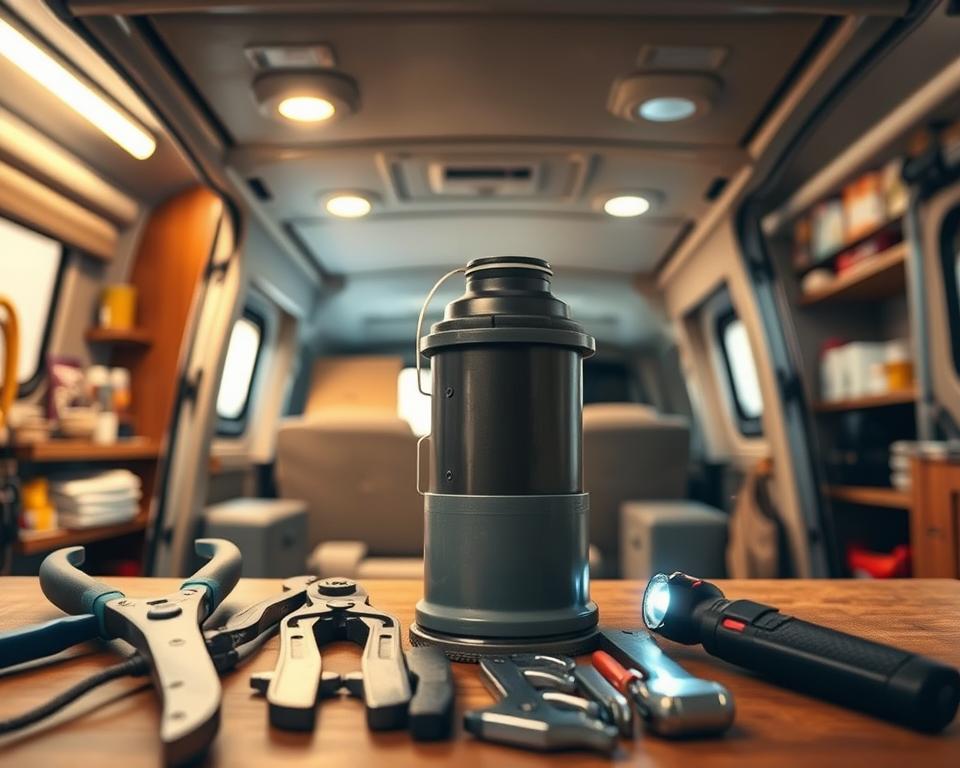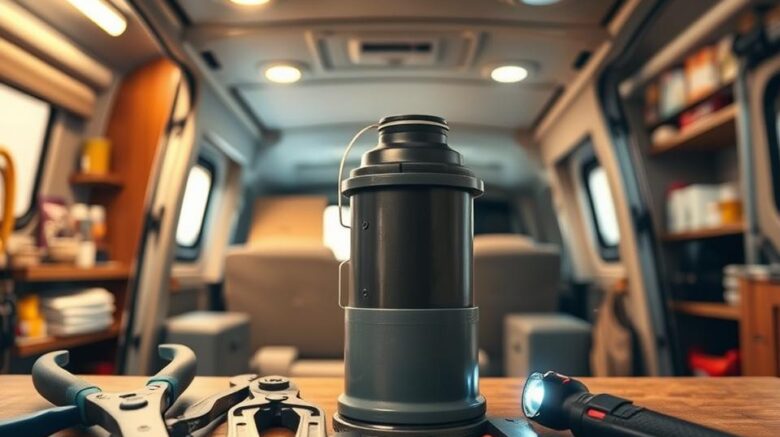RV Waste Tank Pumping: Vital Maintenance Advice
Imagine what happens when you ignore your RV’s sewer setup. A lot of motorhome owners dread tank emptying. However, realizing the importance of these maintenance practices is vital. These steps preserve your camping joy and avoid expensive repairs. Mastering correct waste handling is fundamental to your system’s longevity. We’ll share vital insights on RV grey water pump, including best practices and tips to keep your system running smoothly.
Understanding Your RV Septic System
Every recreational vehicle features a septic setup. The system comprises a black water tank (toilet), a gray water tank (sinks/showers), and a fresh water tank. Knowing these components prevents clogs and ensures efficient cleaning.
A series of drain lines and vent pipes balance waste flow and airflow. Understanding this synergy helps you avoid blockages and buildup. This knowledge ensures hassle-free trips and reliable waste handling.
Maintaining clear, working tanks requires routine effort. Frequently checking tank levels and emptying on time preserves comfort. Proper upkeep extends tank life and enhances every journey.
Why Routine Tank Pumping Matters
Frequent tank pumping keeps your system working and clean. Waste buildup triggers odors and backups that ruin outings. Overfilled tanks risk ugly overflows. These incidents mar your travel enjoyment.
Skipping pump-outs leads to pricey repairs. System failures cause leaks and wear out parts prematurely. Timely emptying keeps your plumbing running smoothly. It prevents unwelcome surprises and roadside emergencies.
Proactive servicing stops clogs. Investing in pump-outs shows you care about your RV. It greatly improves your travel experience. A strict pumping routine lets you enjoy camping without septic concerns.
How Often Should You Pump Your RV Septic Tank?
Timing your tank dumps depends on several variables. Generally, dump every 3–5 days when in use. However, it shifts based on tank volume and number of users. Knowing when to pump is vital for managing RV wastewater.
Dump the black tank at about two-thirds capacity. This prevents solids from clogging and keeps flow steady. Skipping this leads to blockages and smells that spoil the trip.
Various factors influence dump frequency, such as
- Number of people on board
- Length of stay
- Type of waste generated
- Tank capacity
Scheduling prevents on-the-road crises. Sync with any public dump station hours. Knowing your patterns predicts when to dump.
| Usage Scenario | Pumping Frequency |
|---|---|
| Weekend Getaway (2 people) | Every 3–4 days |
| Extended Trip (4–6 people) | Every 2–3 days |
| Seasonal Living (2–4 people) | Weekly or Bi-Weekly |
Monitor fill levels and usage patterns. Staying attentive guarantees a pleasant trip.

Best Practices for Dumping Your Tanks
Correct dumping preserves system health and prevents issues. Always empty the black tank first to protect the gray tank. This prevents dirty water from fouling the clean.
A sturdy sewer hose reduces spill chances and aids flow. Tighten connections to stop spills. Once both tanks are clear, rinse the black tank thoroughly. This removes residue and preps the tank for next time.
Scout dump spots along your route. Being prepared saves time on the road.
In short, follow these key steps for efficient dumping:
- Empty the black water tank first.
- Use a top-quality sewer hose.
- Flush the black tank thoroughly after emptying.
- Plan your dump station locations.
Following these guidelines simplifies black tank maintenance.
How to Care for Your Black and Gray Tanks
Grasping correct handling of black and gray tanks ensures system health. Keep some water in the black tank for better breakdown.
Refrain from disposing non-biodegradable items. Always use RV-safe toilet paper to prevent clogs. Regular checks spot leaks or cracks before they worsen.
Adding treatments now and then improves septic service. They introduce microbes that digest solids effectively. Such measures keep your tanks operating at their best.
- Check for leaks and damage often.
- Apply RV-specific chemical treatments.
- Keep vents clear to avoid odors.
Following these rules protects your septic setup. It also boosts your camping enjoyment.
Essential Pumping Tips
Successful pumping requires precision and a clear procedure. It’s essential to use designated dump stations. Understanding volume limits prevents spills on the go.
Monitoring levels guides your dump schedule. Routine scheduling preserves your septic system and travel enjoyment. Setting a dumping schedule improves system efficiency.
Rinse tanks thoroughly post-dump. It ensures each dump is cleaner than the last. Such tactics keep your rig in top shape and improve your travel experiences.
Avoid These Septic System Errors
Upkeep prevents trip interruptions. Not using enough water in the black tank leads to buildup. Adequate water use breaks down solids efficiently.
Flushing inappropriate items blocks pipes. Avoid non-dissolvable products like feminine hygiene items. Such mistakes can damage plumbing and inflate repair bills.
Leaving the black valve open too early is a mistake. Open valves let water out but hold solids, causing residue. This ensures solids clear on each dump.
Awareness of these errors boosts system longevity. Avoiding them keeps your waste management reliable.
When to Call in Professional RV Waste Disposal Services
Recognizing the need for expert help extends tank life. Lingering smells can mean serious tank problems. Tanks that empty sluggishly hint at internal blockages.
Waste spillage near dump sites signals trouble. It often calls for a deep professional clean. Pros blast away blockages to restore smooth flow.
Regular expert check-ups safeguard tank health. Acting on findings quickly prevents bigger problems. Hiring qualified technicians saves time and money long term.
Sustainable Waste Management Strategies
Long-term strategies sustain wastewater efficiency. Regular pumping boosts system life and function. Routine rinses clear residue and stave off expensive breakdowns.
Implementing clean cycles safeguards tank health. Checking seals and joints avoids leaks. Opting for biodegradable products protects plumbing.
Keep these habits in mind:
- Stick to a pump-out timetable.
- Rinse often to remove solids.
- Sanitize twice a year.
- Inspect parts frequently for wear and tear.
Investing in prevention brings peace of mind. Routine service lets you focus on the scenery, not your sewer.
To Summarize
Good septic care ensures enjoyable trips. Understanding operation and following guidelines prevents headaches. Regular black tank maintenance improves efficiency. This makes your journey more comfortable.
By regularly checking and properly caring for your septic setup, you’ll ensure worry-free travel. Dependable sewage service backs every adventure. These routines prime your rig for future rides. Thus, you can concentrate on adventures rather than septic concerns.
